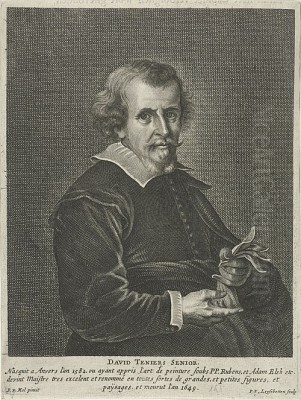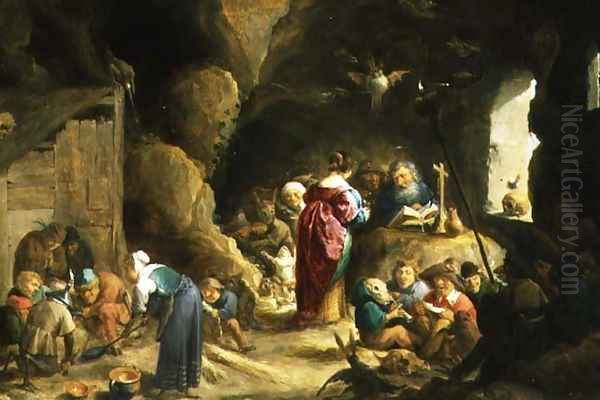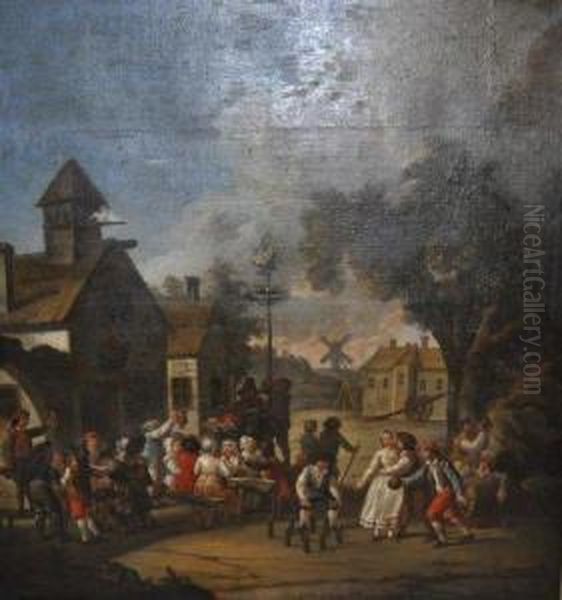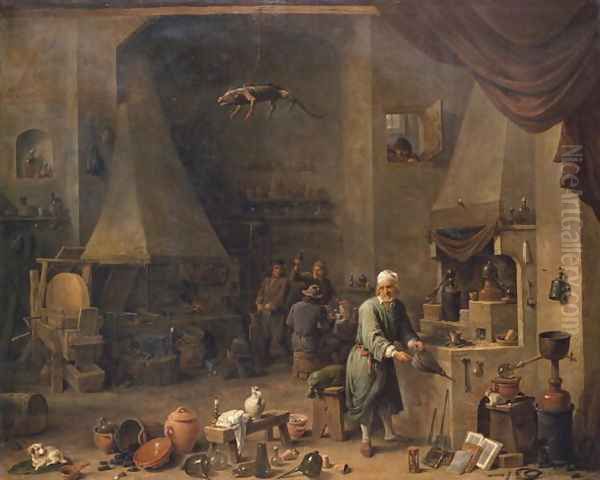
David Teniers the Elder (1582–1649) stands as a significant, if sometimes overshadowed, figure in the rich tapestry of Flemish Baroque art. Born in Antwerp, a vibrant artistic hub, Teniers the Elder carved out a career noted for its versatile engagement with various genres, from grand religious and mythological compositions to intimate landscapes and lively peasant scenes. His work forms a crucial link in the development of Flemish painting, reflecting both the enduring influence of past masters and the burgeoning trends of the 17th century. Though his fame was later eclipsed by that of his son, David Teniers the Younger, the Elder's contributions remain vital for understanding the artistic currents of his time.
Early Life and Artistic Formation in Antwerp
David Teniers was born in Antwerp in 1582 into a city that was a crucible of artistic innovation, still basking in the legacy of earlier Netherlandish masters like Pieter Bruegel the Elder and Hieronymus Bosch, and on the cusp of the Baroque explosion led by Peter Paul Rubens. His initial artistic training was under the guidance of his elder brother, Julian Teniers (1572–1615), who was also a painter. This familial apprenticeship would have provided David with the foundational skills in drawing, composition, and the handling of pigments, following the traditional workshop practices prevalent in Antwerp.
Antwerp's artistic environment was highly competitive and structured around the powerful Guild of Saint Luke, which regulated the training and practice of artists. To become an independent master, an artist typically underwent a lengthy apprenticeship, often followed by a period as a journeyman, and sometimes a formative journey, particularly to Italy. Teniers the Elder's early development was shaped by this local context, absorbing the prevailing tastes for detailed realism and, increasingly, for scenes of everyday life.
The Italian Sojourn: Rubens and Elsheimer

A pivotal phase in Teniers the Elder's development was his journey to Italy, a near-obligatory pilgrimage for ambitious Northern European artists seeking to immerse themselves in classical antiquity and the masterpieces of the Italian Renaissance and contemporary Baroque. In Rome, he reportedly studied with the influential German painter Adam Elsheimer (1578–1610). Elsheimer, though his oeuvre is small, was a master of small-scale cabinet paintings, often on copper, renowned for his poetic landscapes, innovative use of light, and meticulous detail. His influence on Teniers can be seen in the latter's subsequent landscape paintings and his attention to atmospheric effects.
The provided information also suggests that Teniers studied under Peter Paul Rubens (1577–1640) while in Italy. Rubens himself spent a significant period in Italy (1600-1608), absorbing the lessons of Titian, Michelangelo, and Caravaggio, and forging his dynamic Baroque style. If Teniers did indeed work directly with Rubens in Rome, or was closely associated with his circle there, it would have exposed him to a powerful and transformative artistic force. Elsheimer's more intimate and poetic style and Rubens's grand, energetic Baroque would have offered contrasting but equally valuable models. This Italian experience, lasting several years, was crucial in broadening Teniers' artistic horizons beyond his Antwerp origins.
Return to Antwerp and Professional Career
Upon his return from Italy, David Teniers the Elder established himself as an independent master. In 1606, he was officially enrolled as a master in the Antwerp Guild of Saint Luke. This membership was essential for legally practicing as a painter, taking on apprentices, and selling works. His early career saw him tackling large-scale religious, historical, and mythological subjects, a common ambition for painters seeking to demonstrate their skill in complex compositions and figural representation, following the grand manner popularised by Italian art and championed in Antwerp by Rubens.
His workshop would have been active in producing paintings for various patrons, including churches, civic institutions, and private collectors. The art market in Antwerp was sophisticated, and artists often specialized. While Teniers initially focused on these larger, more prestigious commissions, his thematic interests would evolve over time. By the 1630s, records also indicate that David Teniers the Elder was active as an art dealer, a common practice for artists at the time, allowing them to supplement their income and engage more broadly with the art market. This dual role suggests a keen understanding of the business side of art.
Artistic Style and Thematic Evolution
David Teniers the Elder's artistic output is characterized by its versatility, though he became increasingly known for specific genres as his career progressed. His style reflects a blend of influences: the meticulous detail of the Netherlandish tradition, the atmospheric qualities perhaps absorbed from Elsheimer, and the robust vitality of Flemish Baroque.
Early Grand Compositions

In his earlier period, Teniers produced a number of ambitious works with religious, historical, and mythological themes. These paintings often featured numerous figures in dynamic arrangements, demonstrating his ability to handle complex narratives and anatomical rendering. Works from this phase would have aimed to compete with the output of other Antwerp history painters, though perhaps without achieving the same level of widespread acclaim as masters like Rubens or Jacob Jordaens (1593–1678). These compositions, however, laid the groundwork for his later, more specialized production.
The Shift to Genre and Landscape
As his career matured, Teniers the Elder increasingly turned his attention to landscape painting and genre scenes, particularly depictions of rural life, peasant gatherings, kermesses (village festivals), and tavern interiors. This shift mirrored a broader trend in Netherlandish art, where the demand for scenes of everyday life was growing among the burgeoning middle class and discerning collectors. His landscapes often feature expansive vistas, carefully rendered foliage, and a sensitive depiction of light and atmosphere, sometimes with biblical or mythological figures integrated into the scenery, a practice common since Joachim Patinir (c. 1480–1524).
His genre scenes are particularly noteworthy. He depicted peasants at their leisure – carousing, dancing, playing games – with a keen eye for detail and often a touch of humor or "healthy satire," as described in some accounts. These works followed in the tradition of Pieter Bruegel the Elder (c. 1525–1569), whose depictions of peasant life had a profound and lasting impact on Flemish art. Teniers the Elder’s approach, however, was generally less moralizing and more focused on the picturesque and anecdotal aspects of rural existence. His figures are often robust and lively, captured in characteristic poses and interactions.
Characteristic Elements: Humor, Observation, and Color
A defining feature of Teniers the Elder's genre paintings is their observational acuity. He captured the rustic charm and sometimes the boisterous energy of peasant life. His use of color was often rich and varied, though sometimes more subdued in his landscapes to achieve particular atmospheric effects. The "humor" noted in his works is typically gentle, deriving from the depiction of human foibles and everyday situations rather than biting social critique. This made his paintings accessible and appealing to a wide audience. His ability to infuse scenes with a sense of lived reality was a key strength.
Fantastic and Allegorical Scenes

Beyond rural genre, Teniers the Elder also ventured into more imaginative and allegorical subjects. He painted scenes of witchcraft, alchemists in their laboratories, and temptations of Saint Anthony, themes that had a long tradition in Netherlandish art, famously explored by artists like Hieronymus Bosch (c. 1450–1516) and later by his own son, David Teniers the Younger. These subjects allowed for a display of fantasy and the grotesque, often imbued with moral or allegorical undertones. His depictions of alchemists, for instance, tapped into contemporary fascination with and suspicion of such pursuits.
Representative Works
While a comprehensive list of all his works is extensive and attributions can sometimes be complex due to the shared name with his son and other family members who were artists, certain paintings are frequently associated with David Teniers the Elder and exemplify his style.
One such work often mentioned is a "Village Fair" or "Fête aux lauriers." Paintings of kermesses or village festivals were a popular subgenre. These compositions typically teem with figures engaged in various activities – eating, drinking, dancing, flirting, and playing games. Teniers the Elder would have excelled in orchestrating these bustling scenes, capturing the communal spirit and individual vignettes within the larger whole. Such works showcased his skill in figure drawing, narrative, and creating a lively, engaging atmosphere.
Another theme he explored was the "Alchemist's Laboratory." These paintings depict the cluttered and mysterious interiors of alchemists at work, surrounded by furnaces, alembics, books, and strange paraphernalia. These scenes offered a rich opportunity for detailed still-life painting within the composition and played on the ambiguous status of alchemy as both a scientific pursuit and a practice tinged with charlatanism. His treatment of light within these shadowy interiors would have been a key element.
His religious works, such as "The Works of Mercy" or scenes from the lives of saints, would have demonstrated his capacity for more solemn and didactic subjects. Landscape paintings, like "Rocky Landscape with Fishermen," showcase his ability to create depth and atmosphere, often with small figures that animate the scene but remain subordinate to the natural setting. His landscapes often show an affinity with the work of contemporaries like Joos de Momper (1564–1635) or Paul Bril (1554–1626), who was also active in Rome.
Relationships with Contemporaries
David Teniers the Elder operated within a dense network of artists in Antwerp. His primary teachers were his brother Julian and Adam Elsheimer. His relationship with Peter Paul Rubens, whether as a direct pupil in Italy or as a younger contemporary in Antwerp, placed him in proximity to the dominant artistic force of the era.
He was significantly influenced by Adriaen Brouwer (1605/6–1638), a brilliant painter of peasant and tavern scenes whose career, though short, was highly impactful. Brouwer's expressive, often gritty, depictions of low-life subjects set a new standard for the genre. Teniers the Elder's genre scenes, particularly in their earthiness and focus on peasant life, show an awareness of Brouwer's innovations, though Teniers's touch was often lighter and less psychologically intense.
The Bruegel family was another important connection. His son, David Teniers the Younger (1610–1690), would marry Anna Brueghel, the daughter of Jan Brueghel the Elder (1568–1625) and granddaughter of Pieter Bruegel the Elder. This marriage brought the Teniers family into direct lineage with one of the most illustrious artistic dynasties in the Netherlands. Jan Brueghel the Elder, known as "Velvet" Brueghel for his refined technique, was a master of landscapes, flower paintings, and allegorical scenes, and a frequent collaborator with Rubens. The artistic environment was one of collaboration and mutual influence; for example, Rubens often had specialists like Jan Brueghel the Elder paint the landscapes or animals in his compositions.
Other notable Flemish contemporaries whose work would have formed the backdrop to Teniers the Elder's career include Anthony van Dyck (1599–1641), Rubens's most gifted pupil, known for his elegant portraiture; Jacob Jordaens, whose robust style and large-scale compositions rivaled Rubens's; and Frans Snyders (1579–1657), a master of animal painting and hunting scenes. In the broader Netherlandish context, Dutch artists like Frans Hals (c. 1582/83–1666) were contemporaneously developing genre painting with a focus on lively portraiture and scenes of everyday life, while landscape specialists such as Jan van Goyen (1596–1656) and Salomon van Ruysdael (c. 1600/03–1670) were pioneering naturalistic landscape in Holland.
Financial Realities and Later Life
Despite his consistent production and membership in the prestigious Antwerp Guild, David Teniers the Elder did not achieve significant financial success. Historical records indicate that he faced periods of debt, a not uncommon predicament for artists of the time, even those with considerable talent. The art market could be fickle, and securing consistent, lucrative patronage was challenging. It is noted that his sons, including the highly successful David Teniers the Younger, eventually helped him to settle his debts.
This financial struggle contrasts with the immense success achieved by some of his contemporaries, like Rubens, or indeed his own son, who became court painter to Archduke Leopold Wilhelm, Governor of the Spanish Netherlands, and amassed considerable wealth. The Elder Teniers continued to paint throughout his life, adapting his style and themes. He remained in Antwerp, the city of his birth and artistic development, until his death on July 29, 1649.
Legacy and Influence on Later Art
David Teniers the Elder's primary legacy lies in his contribution to the development of Flemish genre and landscape painting. While his son, David Teniers the Younger, would take these genres to new heights of popularity and refinement, the Elder laid important groundwork. His paintings of peasant life, with their characteristic humor and observation, contributed to a tradition that remained popular for centuries. His landscapes, influenced by his Italian sojourn and masters like Elsheimer, show a sensitivity to atmosphere and natural detail that was part of the broader evolution of landscape art in the Low Countries.
His works were collected across Europe, and examples can be found in major museums, including the Louvre in Paris, the Prado Museum in Madrid, and the Kunsthistorisches Museum in Vienna. The popularity of his genre scenes, and those of his son, led to their themes being adapted for other media, such as tapestries, which further disseminated their imagery.
Although often viewed in the shadow of his more famous son, David Teniers the Elder was a painter of considerable skill and originality. He successfully navigated the transition from the grand historical and religious paintings of his early career to the more intimate and popular genres of landscape and peasant scenes. His work reflects the artistic vitality of 17th-century Antwerp and his engagement with key influences like Elsheimer and Brouwer, as well as the overarching presence of Rubens. He trained his four sons – David the Younger, Juliaen, Theodoor, and Abraham – as painters, ensuring the continuation of the Teniers artistic dynasty.
Conclusion: An Enduring Contributor to Flemish Baroque
David Teniers the Elder occupies a respectable and important place in the history of Flemish art. As a contemporary of giants like Rubens and a precursor to the immense success of his own son, he might not always receive the individual spotlight he deserves. However, his oeuvre demonstrates a skilled hand, a keen observational eye, and a versatility that allowed him to contribute meaningfully to several genres. His depictions of rural life, imbued with a characteristic Flemish earthiness and humor, and his atmospheric landscapes, mark him as a significant practitioner of the Baroque era. His journey from Antwerp to Italy and back, his engagement with influential teachers and contemporaries, and his eventual focus on themes that resonated with a broad audience, all paint a picture of a dedicated artist who made a lasting contribution to the rich artistic heritage of the Southern Netherlands. His works continue to be appreciated for their charm, their technical proficiency, and the window they offer into the world of 17th-century Flanders.